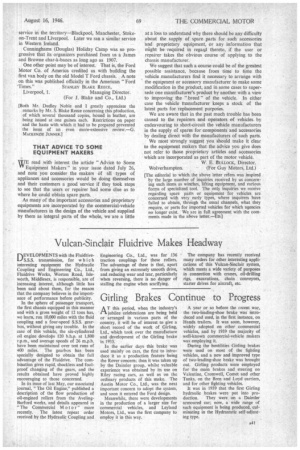Girling Brakes Continue to Progress
Page 43

If you've noticed an error in this article please click here to report it so we can fix it.
AT this period, when the industry's jubilee celebrations are being held or arranged in various parts of the country, it will be of interest to give a short record of the work of Girling, Ltd., which took over the manufacture and development of the Girling brake in 1933.
In the earlier days this brake was used mainly on cars, the first to introduce it as a production feature being the Rover concern: then it was taken up by the Daimler group, whilst valuable experience was obtained by its use on Riley racing cars, as well as on the ordinary products of this make. The Austin Motor Co., Ltd., was the next important concern to adopt the system, and soon it entered the Ford design.
Meanwhile, there were developments in the production of a larger size for commercial vehicles, and Leyland Motors, Ltd., was the first company to employ it in this way. A year or so before the recent war, the two-leading-shoe brake was introduced and used, in the first instance, on Hands trailers. It was soon, however, widely adopted on other commercial vehicles, and by 1939 the majority of well-known commercial-vehicle makers was employing it.
During the hostilities Girling brakes were used on most of the fighting vehicles, and a new and improved type of two-leading-shoe brake was brought out. Girling products were employed for the main brakes and steering on Valentine, Cromwell, Comet and other Tanks, on the Bren and Loyd carriers, and for other fighting vehicles.
It was in 1939 that the first Girling hydraulic brakes were pat into production. They were on a Daimler armoured ear; now, a wide range of such equipment is being produced, culminating in the Hydrastatic self-adjusting type.




































































